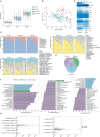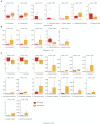Insights from metagenomics into gut microbiome associated with acute coronary syndrome therapy
- PMID: 39035441
- PMCID: PMC11258018
- DOI: 10.3389/fmicb.2024.1369478
Insights from metagenomics into gut microbiome associated with acute coronary syndrome therapy
Abstract
Acute coronary syndrome (ACS) is a predominant cause of mortality, and the prompt and precise identification of this condition is crucial to minimize its impact. Recent research indicates that gut microbiota is associated with the onset, progression, and treatment of ACS. To investigate its role, we sequenced the gut microbiota of 38 ACS patients before and after percutaneous coronary intervention and statin therapy at three time points, examining differential species and metabolic pathways. We observed a decrease in the abundance of Parabacteroides, Escherichia, and Blautia in patients after treatment and an increase in the abundance of Gemalla, Klebsiella variicola, Klebsiella pneumoniae, and others. Two pathways related to sugar degradation were more abundant in patients before treatment, possibly correlated with disorders of sugar metabolism and risk factors, such as hyperglycemia, insulin resistance, and insufficient insulin secretion. Additionally, seven pathways related to the biosynthesis of vitamin K2 and its homolog were reduced after treatment, suggesting that ACS patients may gradually recover after therapy. The gut microbiota of patients treated with different statins exhibited notable differences after treatment. Rosuvastatin appeared to promote the growth of anti-inflammatory bacteria while reducing pro-inflammatory bacteria, whereas atorvastatin may have mixed effects on pro-inflammatory and anti-inflammatory bacteria while increasing the abundance of Bacteroides. Our research will provide valuable insights and enhance comprehension of ACS, leading to better patient diagnosis and therapy.
Keywords: acute coronary syndrome; gut microbiota; intestinal; metabolism; metagenome; statin.
Copyright © 2024 Guan, Zhao, Li, Zhang, Guo, Luo, Jiang, Li, Liu, Chen, Zhao and Zhang.
Conflict of interest statement
SZ and ZiZ are employed by Shenzhen Byoryn Technology Co., Ltd. The remaining authors declare that the research was conducted in the absence of any commercial or financial relationships that could be construed as a potential conflict of interest.
Figures




Similar articles
-
Overrepresentation of Enterobacteriaceae and Escherichia coli is the major gut microbiome signature in Crohn's disease and ulcerative colitis; a comprehensive metagenomic analysis of IBDMDB datasets.Front Cell Infect Microbiol. 2022 Oct 4;12:1015890. doi: 10.3389/fcimb.2022.1015890. eCollection 2022. Front Cell Infect Microbiol. 2022. PMID: 36268225 Free PMC article.
-
Efficacy of high-dose atorvastatin or rosuvastatin loading in patients with acute coronary syndrome undergoing percutaneous coronary intervention: a meta-analysis of randomized controlled trials with GRADE qualification of available evidence.Eur J Clin Pharmacol. 2022 Jan;78(1):111-126. doi: 10.1007/s00228-021-03196-9. Epub 2021 Aug 23. Eur J Clin Pharmacol. 2022. PMID: 34423376
-
Antiatherosclerotic effects of long-term maximally intensive statin therapy after acute coronary syndrome: insights from Study of Coronary Atheroma by Intravascular Ultrasound: Effect of Rosuvastatin Versus Atorvastatin.Arterioscler Thromb Vasc Biol. 2014 Nov;34(11):2465-72. doi: 10.1161/ATVBAHA.114.303932. Epub 2014 Sep 11. Arterioscler Thromb Vasc Biol. 2014. PMID: 25212234 Clinical Trial.
-
Type-2 Diabetes Mellitus and the Gut Microbiota: Systematic Review.Cureus. 2023 Nov 30;15(11):e49740. doi: 10.7759/cureus.49740. eCollection 2023 Nov. Cureus. 2023. PMID: 38161953 Free PMC article. Review.
-
The gut microbiome in coronary artery disease and heart failure: Current knowledge and future directions.EBioMedicine. 2020 Feb;52:102649. doi: 10.1016/j.ebiom.2020.102649. Epub 2020 Feb 12. EBioMedicine. 2020. PMID: 32062353 Free PMC article. Review.
Cited by
-
A two-sample Mendelian randomization study reveals the causal effects of statin medication on gut microbiota abundance in the European population.Front Genet. 2024 Dec 13;15:1380830. doi: 10.3389/fgene.2024.1380830. eCollection 2024. Front Genet. 2024. PMID: 39734574 Free PMC article.
References
LinkOut - more resources
Full Text Sources

